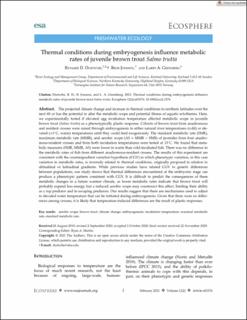| dc.description.abstract | The projected climate change and increase in thermal conditions in northern latitudes over the next 60 yr has the potential to alter the metabolic scope and potential fitness of aquatic ectotherms. Here, we experimentally tested if elevated egg incubation temperature affected metabolic scope in juvenile brown trout (Salmo trutta) as a phenotypically plastic response. Cohorts of brown trout from anadromous and resident crosses were raised through embryogenesis in either natural river temperatures (cold) or elevated (+3°C, warm) temperatures until they could feed exogenously. The standard metabolic rate (SMR), maximum metabolic rate (MMR), and aerobic scope (AS = MMR − SMR) of juveniles from four anadromous- resident crosses and from both incubation temperatures were tested at 13°C. We found that metabolic measures (SMR, MMR, AS) were lower in warm than cold-incubated fish. There was no difference in the metabolic rates of fish from different anadromous-resident crosses. The results of this experiment are consistent with the countergradient variation hypothesis (CGV) in which phenotypic variation, in this case variation in metabolic rates, is inversely related to thermal conditions, originally proposed in relation to altitudinal or latitudinal gradients. While previous studies have related CGV to genetic differences between populations, our study shows that thermal differences encountered at the embryonic stage can produce a phenotypic pattern consistent with CGV. It is difficult to predict the consequences of these metabolic changes in a future warmer climate, as lower metabolic rates indicate that brown trout will probably expend less energy, but a reduced aerobic scope may counteract this affect, limiting their ability as a top predator and in escaping predators. Our results suggest that there are mechanisms used to adjust to elevated water temperature that can be initiated during embryogenesis. Given that there were no differences among crosses, it is likely that temperature-induced differences are the result of plastic responses. aerobic scope; brown trout; climate change; embryogenesis; incubation temperature; maximal metabolic rate; standard metabolic rate. | en_US |

